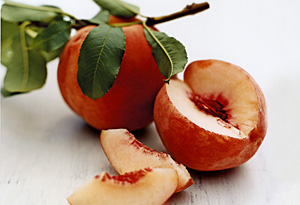Cooking with Summer Fruits

Photo: Ditte Isager
It's that head-over-heels time of year: the brief, sweet season when peaches, plums, apricots, and nectarines are at their most maddeningly luscious. Invent an alibi, bolt the door, and get ready to swoon.
The plot could be straight out of a romance novel, complete with passion, devotion, betrayal, and rejection. The story of America's love affair with peaches, plums, apricots, and nectarines has everything but ripped bodices and heaving bosoms. Including a happy ending.Get the recipes
Though their common name—stone fruits—sounds appropriate for a garage band, these summer gems are actually all botanical cousins of the rose. And what impractical creatures they are. They refuse to be eaten politely, thanks to their soft, raggedy pulp and prolific juices. Pack them in a lunch box, and they collapse into a mass of sticky bruises. Even their appearance is slightly indecent, with tender flesh swelling beneath skin indented by a gentle cleft.
Yet so delectable is their flavor that gardeners, cooks, and scholars have happily overlooked these shortcomings since 2000 B.C., and were often moved to extol their virtues in poem and song. Along the way, inquisitive people also found value in the pits, from which they extracted remedies for impotence, tumors, and baldness (for the latter you had to boil peach pits in vinegar, then tie them to your head, which, if nothing else, ensured that no one would think baldness was your primary problem). Treachery, too, resided deep within these fruits, for those pits also contain cyanide, useful for dispatching a tiresome king or bothersome spouse.
But seductive stone fruits have grown scarce of late, at least if you shop in grocery stores. Yes, spectacular versions persist, but to experience them you have to visit an orchard or greenmarket where locally grown, tree-ripened fruit is sold. "There is fruit out there that tastes so good, you would not believe it," says Thomas Gradziel, professor of plant sciences at the University of California, Davis. That's because stone fruits accumulate sweetness and perfume—or "volatile aromatic compounds," as Gradziel puts it—only while they cling to the branch, unlike apples, kiwis, pears, and bananas, which gather starch while growing and turn sweet after they're picked. "With stone fruits, tree-ripe is best," says Gradziel, "but it's also softest. For a long time, commercial growers solved this by harvesting the fruit early, while it was still hard and would ship well."
Growers weren't the only ones trying to fix stone fruits' so-called problems. Horticultural scientists also went to work, engineering fruits that would look good in the store. They fiddled with color, and plums got darker (the better to hide blemishes). They tinkered with size, and peaches got bigger (the better to catch a shopper's eye). They adjusted firmness, and stone fruits got harder, until the specimens that filled grocers' shelves had all the charm of raw potatoes.



